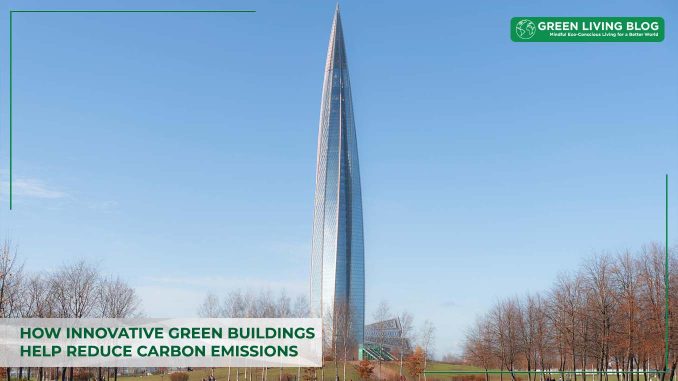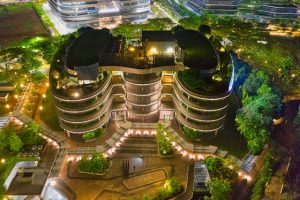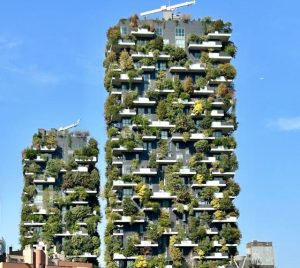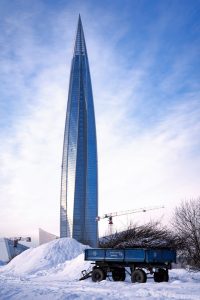
You’ve probably imagined a future green city with vines crawling up the siding, and community gardens transforming city centers.
Adding greenery is part of the solution to reduce carbon emissions, but so is adding more green buildings in the world.
Innovations have made infrastructure more carbon-friendly than ever, and countless creative minds are breaking ground to craft the eco-conscious buildings of the future.
Carbon Footprint of Buildings

The construction and building sector contributes 37% of global emissions because it is an umbrella for many other carbon-heavy industries. Consider all the wood, glass, cement, steel and aluminum going into your favorite spots in town — extraction, processing, construction and lifetime use add up fast. Embodied and operational emissions are both parts of the problem, worsening other environmental concerns such as the urban heat island effect.
The planet needs green buildings, otherwise its footprint will continue to skyrocket without end. Population growth and urbanization are driving factors behind the need for rapid building construction. However, there are more than residential buildings motivating expansion. Bustling industry, a rise in startups and small businesses, and nonprofit housing projects will damage the planet further unless experts re-imagine how everything is built.
The urgency for more green buildings in the world rises if you know the benefits decarbonization brings to every other sector. It allows the natural world to heal from the adverse effects of the climate crisis. Simultaneously, it streamlines things like codes, legislation and investor interests. This needs to align stakeholder interests across all businesses and homes. When green buildings are the expectation instead of the exception, everywhere will have improved:
- Air quality
- Heating and cooling energy use
- Waste generation
- Water consumption
Ways to Reduce Carbon Emissions

Green buildings could reduce energy consumption by 25% and potentially more as research expands. Novel green buildings could supply and promote resource generation instead of sapping it. What are the ways new green buildings are doing this?
Climate objectives range from the Paris Agreement to the United Nations’ Sustainable Development Goals. Money is necessary to build sustainable infrastructure, upgrade the old with eco-friendly technologies, and stabilize prices on expensive green equipment.
Fortunately, the planet is joining together to do this. An alliance gathered $35 trillion in investments to assist buildings with the energy transition required by 2030. It is the most monumental funding movement in this space in history, setting a precedent for the future.
What kind of projects will this money go to? The possibilities are endless, because the way green buildings manifest is diverse around the world. It could have any of the following qualities:
- Prefab or modular design and manufacturing
- Urban greenery projects
- Climate-resilient infrastructure retrofits
- Passive design
- LEED and other related certification
- Biomimicry elements
Developing Green Buildings in the World

What are some examples of sustainable building expansion that prove green buildings will become more common?
Paris 2024 Olympics
The amount of infrastructure needed to house athletes and supporters relies on often destructive, fast project timelines. Historically, this provides economic boons but tears up countless areas in the world’s major cities. To continue enjoying the collaboration and global mindset The Games promote, this aspect needs to be more eco-friendly. The Paris 2024 Olympics are trying to pave the way.
With the city warmer than it was the last time it hosted Olympians, the facilities needed to be considerate. The committee was inspired to aim to produce half the emissions of London 2012 and Rio 2016, which was about 3.5 million tons. They have no air conditioning, low-carbon menus, renewable energy when possible, and carbon offsets. The urgency for green buildings is asserted by the questions environmental experts have about the effectiveness of this plan. Public concern is present and will harm the celebration if greenwashing is an Olympic undertone.
Lakhta Center, Russia
This impressive skyscraper is 1,516 feet tall, yet it manages unprecedented levels of sustainability. It is a LEED Platinum-certified structure using a double-skin facade to make it use less energy and hold heat better than other designs. It circulates heat to power itself, encouraging a circular mindset.
Chicago, Illinois
Around 57% of people worldwide live in urban areas. This number will increase as digitization and opportunities blossom in city hubs. These regions need green buildings if they want to remain attractive to people. Chicago’s green architecture movement is trying to set the example.
Its predominantly 19th-century masonry buildings were inspired by efficiency-seeking architects. The historical comparison of these buildings, which are effective at using natural shade and ventilation to their advantage, to environmentally destructive new builds shows harming the planet with the building sector was a choice. It isn’t perfect, but it’s a notable analysis.
Now, the city has predominantly LEED-certified workspaces, updated energy and benchmarking ordinances to guide development, and even demolition debris recycling rules to minimize construction’s embodied emissions. It handles green advancement well for a city with famously high winds and chilling temperatures.
Reduce Carbon Emissions in Structures
Green buildings in the world are becoming more technologically advanced and better at keeping the planet intact. Humanity needs them to enjoy society guilt-free. However, it is also essential to reverse climate change, otherwise conditions will be so severe that you won’t be able to enjoy buildings at all. Collaboration and dedication are focal in sustainable infrastructure development.
![]()
Author Profile
- Online Media & PR Strategist
- Blogger and Educator by Passion | Senior Online Media & PR Strategist at ClickDo Ltd. | Fascinated to Write Lifestyle Blogs in News & Education I have completed a journalism summer course at the London School of Journalism and manage various blogs.
Latest entries
 LeisureApril 16, 202510 Best Green UK Hotels for Eco-Tourists
LeisureApril 16, 202510 Best Green UK Hotels for Eco-Tourists Best practicesApril 14, 20258 Best Ways to Reduce Your Carbon Footprint
Best practicesApril 14, 20258 Best Ways to Reduce Your Carbon Footprint Green Expert GuidesMarch 28, 2025Lisbon Living: Where Sustainable Charm Meets Urban Energy
Green Expert GuidesMarch 28, 2025Lisbon Living: Where Sustainable Charm Meets Urban Energy EnvironmentJanuary 21, 2025Buying Eco-Friendly Homes: 6 Eco Questions to Ask Your Real Estate Agent
EnvironmentJanuary 21, 2025Buying Eco-Friendly Homes: 6 Eco Questions to Ask Your Real Estate Agent






Leave a Reply
You must be logged in to post a comment.